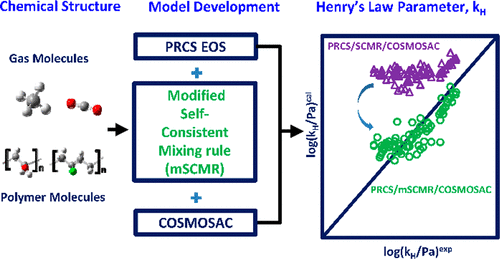当前位置:
X-MOL 学术
›
Ind. Eng. Chem. Res.
›
论文详情
Our official English website, www.x-mol.net, welcomes your
feedback! (Note: you will need to create a separate account there.)
Prediction of Gas and Liquid Solubility in Organic Polymers Based on the PR+COSMOSAC Equation of State
Industrial & Engineering Chemistry Research ( IF 3.8 ) Pub Date : 2018-07-17 , DOI: 10.1021/acs.iecr.8b01780 Li-Hsin Wang,Chieh-Ming Hsieh,Shiang-Tai Lin
Industrial & Engineering Chemistry Research ( IF 3.8 ) Pub Date : 2018-07-17 , DOI: 10.1021/acs.iecr.8b01780 Li-Hsin Wang,Chieh-Ming Hsieh,Shiang-Tai Lin

|
The predictive capability of gas and liquid solubility in organic polymers is examined based on the combination of the PR+COSMOSAC equation of state (EOS) and the COSMO-SAC liquid model through three different excess Gibbs free energy based mixing rules, modified Huron-Vidal (MHV1), Wong-Sandler (WS), and self-consistent mixing rule (SCMR). Using 81 binary systems consisting of 23 gas molecules and 22 polymers (81 data points) with temperatures ranging from 298 to 461 K, it is found that WS and SCMR can provide reasonable prediction accuracy (RMSE(log10 kH) = 0.746 and 1.725, respectively) for the Henry’s law parameter in polymers, while the MHV1 mixing rule results in a much larger error (RMSE (log10 kH) = 3.118) compared to experiment. The WS and SCMR, but not MHV1, provide a converged value of Henry’s law parameter of gas in polymers as the molecular weight of the polymer increases. We further propose a modification to the SCMR (mSCMR) that results in significant improvement in the solubility prediction in polymers (RMSE (log10 kH) = 0.305) and the binary vapor–liquid equilibrium for common molecules. In this new approach, referred to as PRCS/mSCMR/COSMOSAC, all species-dependent parameters are determined from quantum mechanical (QM) calculations, and no adjustable parameters are required for the gas–polymer binary pairs. We believe that this new method may provide useful assistance to the development of polymer membrane-based gas separation processes especially when experimental information is not yet available.
中文翻译:

基于状态方程PR + COSMOSAC的有机聚合物中气体和液体溶解度的预测
通过PR + COSMOSAC状态方程(EOS)和COSMO-SAC液体模型的组合,通过三种不同的基于吉布斯自由能的混合规则,改进的Huron-Vidal,检验了气体和液体在有机聚合物中的溶解性的预测能力(MHV1),Wong-Sandler(WS)和自洽混合规则(SCMR)。使用由23种气体分子和22种聚合物(81个数据点)组成的81个二元系统,温度范围为298至461 K,发现WS和SCMR可以提供合理的预测精度(RMSE(log 10 k H)= 0.746和1.725分别针对聚合物中的亨利定律参数,而MHV1混合规则会导致更大的误差(RMSE(log 10 k H)= 3.118)。随着聚合物分子量的增加,WS和SCMR(而不是MHV1)提供了聚合物中气体的亨利定律参数的收敛值。我们进一步建议对SCMR(mSCMR)进行修改,以显着改善聚合物中的溶解度预测(RMSE(log 10 k H)= 0.305)和常见分子的二元气液平衡。在这种称为PRCS / mSCMR / COSMOSAC的新方法中,所有与物种有关的参数都是从量子力学(QM)计算中确定的,并且气体-聚合物二元对不需要任何可调参数。我们认为,这种新方法可能为开发基于聚合物膜的气体分离工艺提供有用的帮助,尤其是在尚无实验信息的情况下。
更新日期:2018-07-18
中文翻译:

基于状态方程PR + COSMOSAC的有机聚合物中气体和液体溶解度的预测
通过PR + COSMOSAC状态方程(EOS)和COSMO-SAC液体模型的组合,通过三种不同的基于吉布斯自由能的混合规则,改进的Huron-Vidal,检验了气体和液体在有机聚合物中的溶解性的预测能力(MHV1),Wong-Sandler(WS)和自洽混合规则(SCMR)。使用由23种气体分子和22种聚合物(81个数据点)组成的81个二元系统,温度范围为298至461 K,发现WS和SCMR可以提供合理的预测精度(RMSE(log 10 k H)= 0.746和1.725分别针对聚合物中的亨利定律参数,而MHV1混合规则会导致更大的误差(RMSE(log 10 k H)= 3.118)。随着聚合物分子量的增加,WS和SCMR(而不是MHV1)提供了聚合物中气体的亨利定律参数的收敛值。我们进一步建议对SCMR(mSCMR)进行修改,以显着改善聚合物中的溶解度预测(RMSE(log 10 k H)= 0.305)和常见分子的二元气液平衡。在这种称为PRCS / mSCMR / COSMOSAC的新方法中,所有与物种有关的参数都是从量子力学(QM)计算中确定的,并且气体-聚合物二元对不需要任何可调参数。我们认为,这种新方法可能为开发基于聚合物膜的气体分离工艺提供有用的帮助,尤其是在尚无实验信息的情况下。










































 京公网安备 11010802027423号
京公网安备 11010802027423号